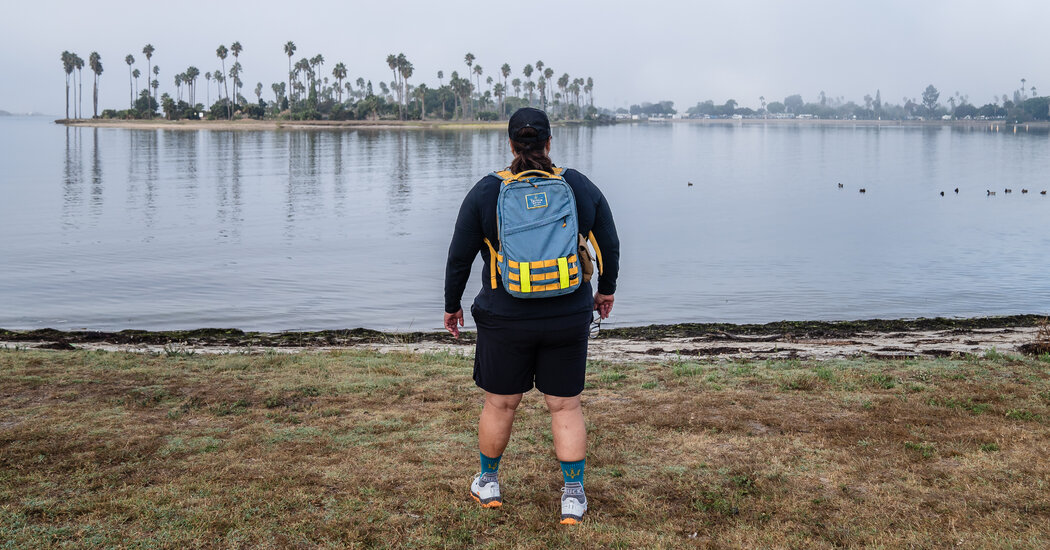[ad_1]
When Jessica Flores was in her mid-40s, she began experiencing shortness of breath, fatigue, swelling in her legs and a rapid heartbeat. When she ended up in the hospital, the doctors told her she had congestive heart failure, and that she needed to change her diet and start exercising.
Knee injuries made it difficult to run, but in 2019, she registered for a 5K race anyway. That’s when she noticed an option to walk the race with a weighted backpack, known as “rucking.”
“That changed my life,” Ms. Flores said.
She bought a backpack and a 20-pound weight and began walking around her neighborhood. She placed third in the rucking race, and by the end of that year, she had rucked a marathon in seven hours and lost more than 100 pounds.
“My weight loss and my physical activity had completely reversed the congestive heart failure,” Ms. Flores said.
While it’s experiencing a burst in popularity, with wellness gurus and influencers getting in on the trend, rucking isn’t new — and it’s not complicated. If you can walk, you can ruck. You can incorporate it into everyday activities or use the weight to intensify movements like lunges and push-ups.
Here’s how to get started.
Why ruck?
The term “rucking” originated in the military from the word “rucksack,” or backpack. Carlos Grider, who runs the travel website A Brother Abroad, was introduced to rucking in the Marines and now incorporates it into his civilian life.
“Instead of going to a gym, I walk to the grocery store and come home with everything I need for a week on my back,” he said.
Any walking over a long period of time can build cardiovascular endurance, but rucking is a low impact way to increase strength and bone density, said Jennifer Earl-Boehm, an associate professor of rehabilitation sciences at the University of Wisconsin-Milwaukee.
There are few large studies on rucking, but smaller ones suggest walking with a weighted backpack builds muscular endurance, stamina and strength. A 155-pound person burns about 430 calories per hour jogging at a moderate pace, but can burn about 100 calories more in the same time by walking four miles an hour at a slight incline carrying a 20-pound pack.
It’s possible to ruck on a treadmill, but experts say that kind of defeats the purpose. At it’s heart, the sport is about getting outdoors, which itself has been tied to improved cognitive function, brain activity, blood pressure, mental health and sleep.
How do you get started?
The main piece of rucking equipment is something almost everyone has tucked away somewhere: a backpack.
“If you have anything that weighs anything in your house, put that inside the backpack and simply go for a walk. It could be books, it could be bottles of water, it could be soup cans,” said Michael Easter, who teaches journalism at the University of Las Vegas and wrote “The Comfort Crisis,” which helped popularize rucking.
Any sturdy and comfortable backpack will do. Once you get serious, you can invest in a rucking-specific pack with weight plates from a company like GORUCK or 5.11 Tactical, which have handles designed for using the pack like a kettlebell or dumbbell to create a full body workout, said Mr. Grider.
For footwear, Dr. Earl-Boehm recommends a shoe with cushioning in the heel. If you ruck on trails, choose a hiking or trail shoe with ankle support, along with lightweight wool socks.
The first rucks
If you don’t walk regularly, you can start with an empty backpack or only use light weights. If you are accustomed to walking for exercise, you can start rucking for 30 minutes over even ground at a brisk pace two to three days a week, said Rob Shaul, founder of Mountain Tactical Institute, which develops training plans for mountain athletes and people in the military. Use a load that feels slightly challenging — around 10 to 20 pounds for most women, or 15 to 40 pounds for men.
But go slowly. In a study of R.O.T.C. cadets, Dr. Earl-Boehm found that fatigue and impact on the body when rucking were tied to ankle strength. She recommends incorporating ankle strengthening exercises into your routine. If you’re rucking on steep, rocky terrain you could add in trekking poles. Or join a rucking club to learn the ropes and find a community to motivate you.
Adding distance or weight
After about two weeks, Mr. Shaul suggests increasing the load by five or 10 pounds, but sticking to 30 minutes. Then, if that feels manageable, increase to 45 minutes after another two weeks. Two weeks later try rucking for 60 minutes with the same weight.
A good pace to aim for is 15 minutes or less per mile, he added. Want to increase your speed? Try swinging your arms.
The full rucking workout.
Once you are comfortable rucking, experiment with more intense elements. Mr. Grider has created a variety of workouts to build strength and raise your heart rate. Here are three of his favorites. Try each of the three additions to make your ruck more challenging.
Upper-body conditioning
Every five to 10 minutes during your ruck:
Lower body strengthening
If you’d like to strengthen your lower body even more during a ruck, add in lunges. At predetermined time (about every 10 minutes) or distance (about every half mile), stop and perform walking lunges for about 50 to 100 yards.
Interval training
The best way to increase your rucking speed is to add in interval training. Alternate between low and high speeds in five- to 10-minute intervals throughout your half-hour ruck.
Hilary Achauer is a freelance writer focused on fitness, health, wellness and parenting.
[ad_2]
Source link

